My top recommendation is to get your child's vision tested as close to six months as possible. Assessments at six to twelve months of age can determine healthy development of vision. The best way to ensure a baby has healthy vision for successful development now and in the future is by early detection of eye conditions.
Olivia and Sophia in the backyard.
(Taken on December 26, 2007.)
Olivia with one of her eye patches.
She wore it for 14 hours per week (about 2 hours per day)
so her brain would use her left eye and
she wouldn't lose all the vision in it.
(Taken on November 17, 2011.)
Although problems are not common, it is important to identify children who have specific risk factors at this stage. Eye health problems and vision development can be more easily corrected if treatment is begun early.
I'm recommending this because this is something that I did not know about that should be done. In fact, it is only because I put Olivia and Sophia in a chair one day a couple of feet from the television. Normally, they didn't watch television when they were young. On this particular day, I needed to get some work done, and thought it would be okay if they would watch a bit of "Sesame Street."
They were watching the show, and I was working in my home office for a bit. Came out to check on them and noticed that Olivia was squinting. Asked her why she was squinting. She couldn't see the picture, she told me.
Called and made an appointment with an optometrist. After examining Olivia, she said she had not seen vision that bad, and recommended seeing an ophthalmologist.
Olivia's ophthalmologist.
The ophthalmologist confirmed what the optometrist thought: Olivia was legally blind in both eyes. What was challenging was that her left eye was significantly worse than her right eye. Potentially, her brain would use her right eye and not her left eye; and from non-use she would lose all sight in it.
For several years, Olivia wore a patch on her right eye so it would strengthen her left eye. Generally this was done at home and/or in the car, not when she was in public.
Quarterly, she would go to the ophthalmologist to have her vision tested. About every 6-9 months, she needed a new pair of glasses because her vision was changing.
The ophthalmologist said she was proud of Olivia for wearing her eye patch and doing things while wearing it - like coloring, looking at pictures in books, and playing. Because of this and her glasses, the vision in her left eye was improving. (Some parents put the patch on their child and then the child takes a nap. It is counter-productive to do this since the eye isn't being used when the eyelid is closed.)
Olivia coloring in one of her coloring books.
(Taken on November 4, 2008.)
In addition to her vision issue, the lashes on her upper eyelids were rubbing on her corneas and scratching them. She needed a nightly "goopy medicine" (as we called it). This protected her corneas from being further scratched.
In the picture above, Olivia was not wearing her glasses so I kept trying to tell her to look up a bit more so she would look at the camera. I don't think she knew exactly where to look.
She had been frustrated at that time because she didn't like wearing her glasses or eye patch (she had to wear it daily for 2 hours so she didn't lose all her vision in her left eye). "I wish I wasn't blind," was her new comment almost daily when she was about 5 years old. (Taken on June 30, 2008.)
There were also times when she needed eye drops when her eyes needed to be dilated for eye appointments. These had to be given to her three days in advance of an appointment so her pupils were fully dilated. Needless to say, this was not comfortable for her (imagine having dilated pupils and all the light going into your eyes for multiple days).
Olivia doing embroidery work.
Although wearing an eye patch was not
her favorite part of the day,
her favorite part of the day,
her willingness to wear it was helping improve her vision.
(Taken on October 23, 2008.)
Eventually, as she started to get older, her eyelids changed their shape enough that the eyelashes flipped up rather than towards her eyes. The "goopy medicine" could be stopped.
At this point, her vision is as good as it probably will get with glasses. She is now down to a yearly eye appointment. This is a major change from the quarterly appointments.
Olivia at her most recent eye appointment
when she was told the good news:
you don't have to come back until a year from now!
So, if you've missed the six month mark, it's not too late to your child in to have her vision checked. There's so much that can be done proactively these days; and that will have a life-long impact on a child's vision and health of her eyes.

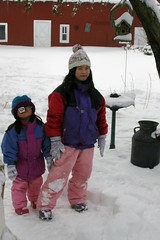
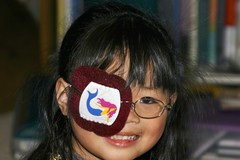
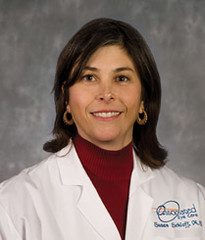

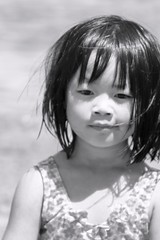
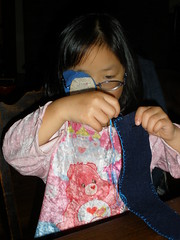


8 comments:
Oh, great advice! We just took all our kids to the eye dr this year for the first time and found out that our oldest (8) needed glasses. It was a surprise, we had no idea.
Thank goodness you caught her eye problems early and were able to work on treating them!
Eyesight isn't something that I thought about until Kindergarten. Then I found out that my son needed glasses.
What a great piece of advice!
I think I will call this week and see about getting my daughter an appointment.... so there can be a baseline. Thank you.
When I was young they didn't notice you needed glasses until you were sitting too close to the TV and needed to be in the front row in class to see the board. I went in third grade and was already quite nearsighted. Good advice!
Are the girls sisters? I wondered since you thought they might have similar eye problems.
Rita, you asked if the girls are sisters. Through adoption they are, but not biologically. Sophia is from the east-central part of China; and Olivia is from the west-central part of China.
Both have similar histories in that they were abandoned in very public places, and were found by a person who brought them to the police station. An officer then brought them to the orphanage in their respective cities where they lived for 10 months (Olivia) and 11 months (Sophia) until they were adopted.
In terms of vision, Olivia was born with vision issues, but no one ever checked her eyes while she was at the orphanage. Sophia's vision issues are a result of a rapid growth spurt. Apparently, eyes/vision can change quite a bit when children undergo a rapid change vs. gradual one. I didn't know that until she went to the optometrist after complaining about headaches.
I have to hand it to Olivia for being such a trooper! I know that must have been frustrating for her. Glad to hear things are getting better for her!
Your Daughter is an inspiration. She is a strong girl to do all these things. My 3 yr old had her eyes checked for the first time at a few weeks ago. I had no idea this was something I should have done sooner!
You and your daughters are an inspiration. Each story you tell is so full of love and patience, even when you are telling of obstacles y'all have had to overcome.
Post a Comment